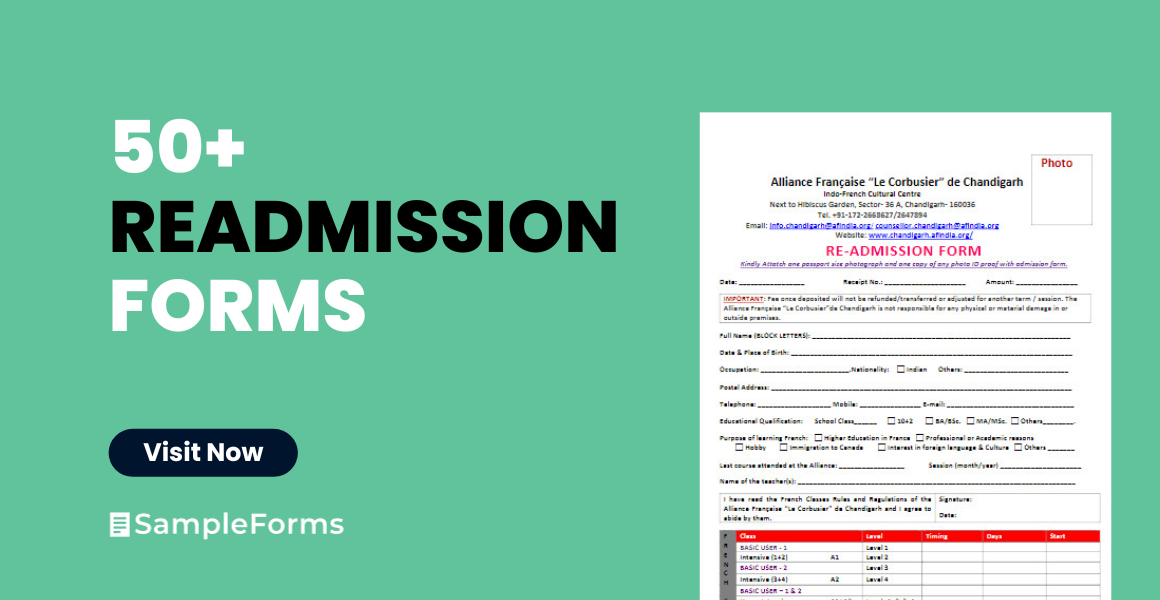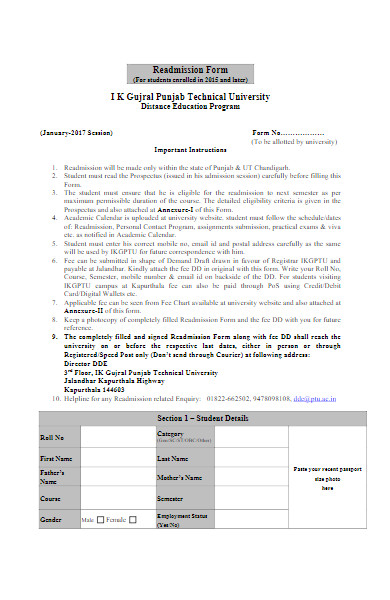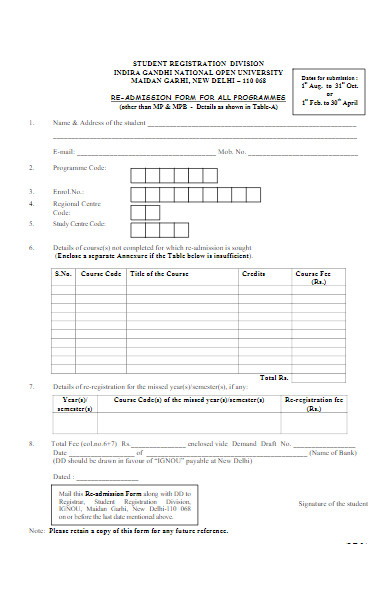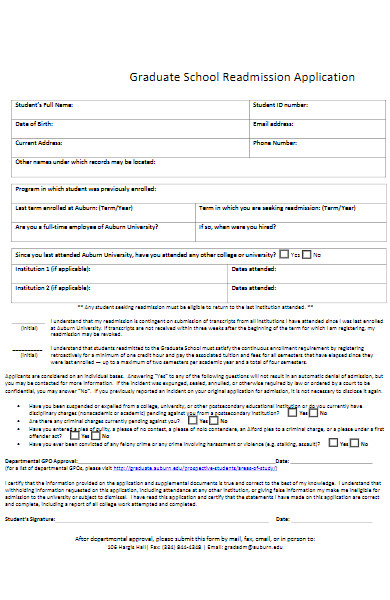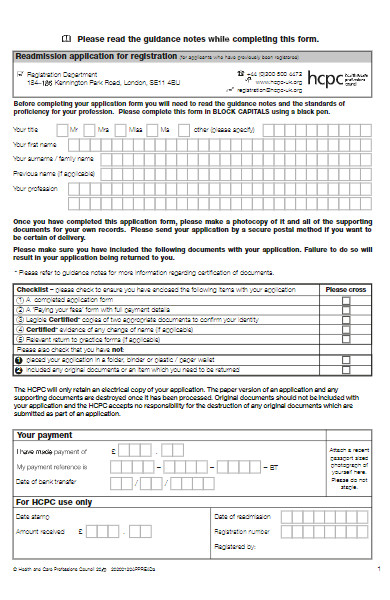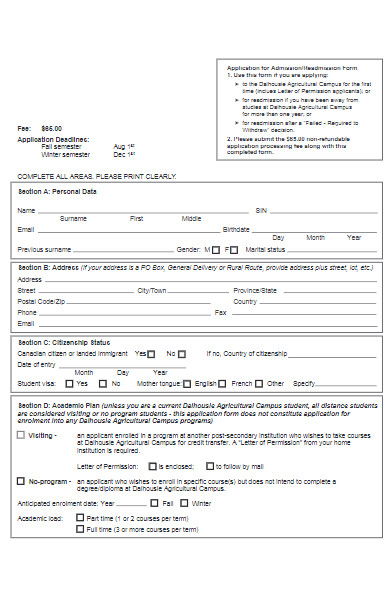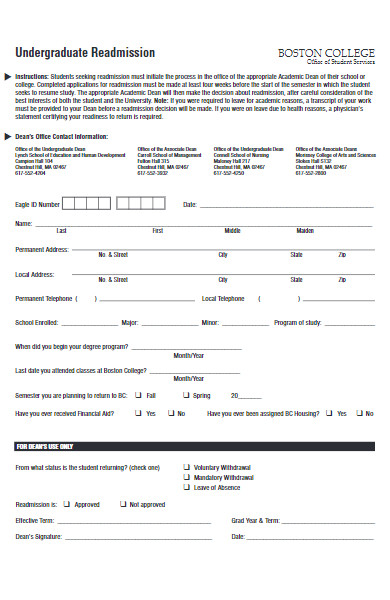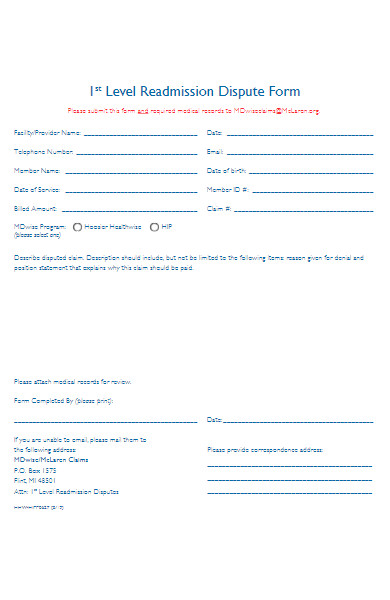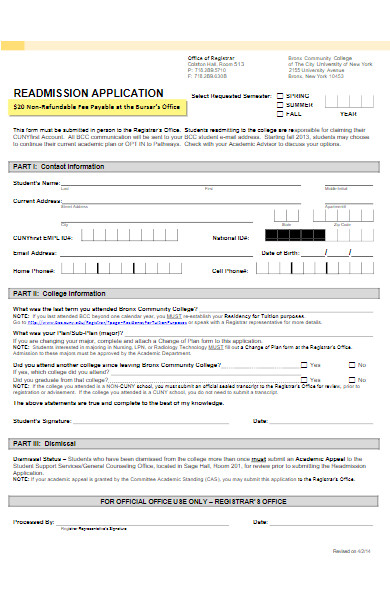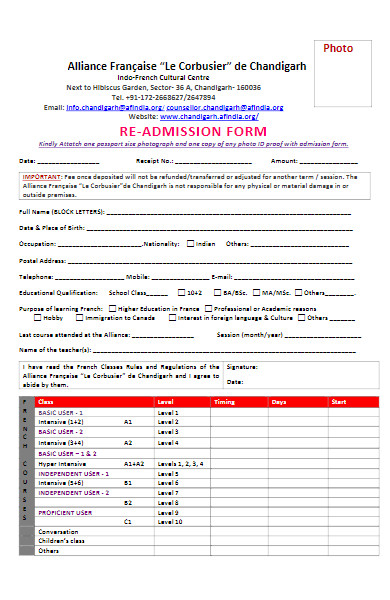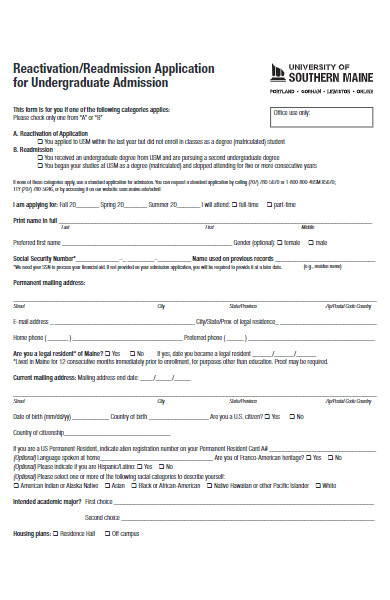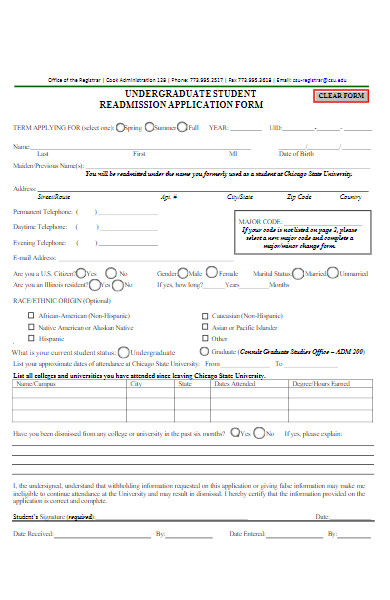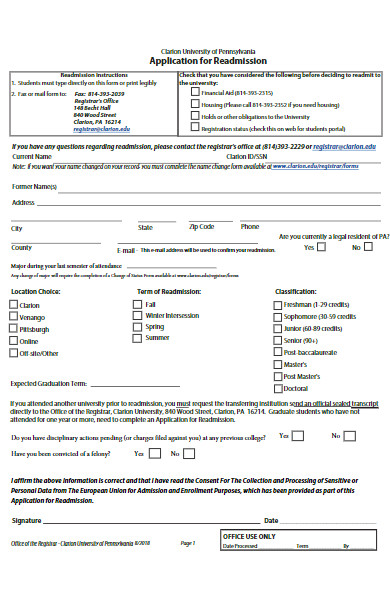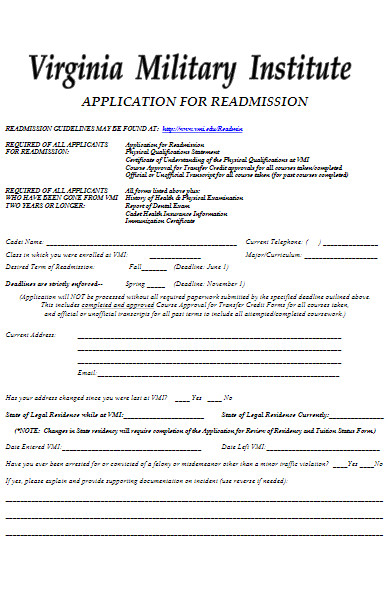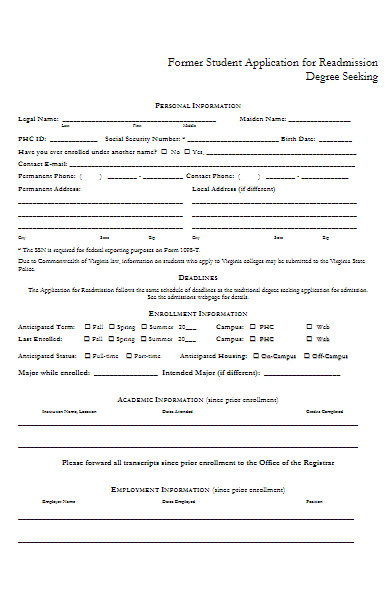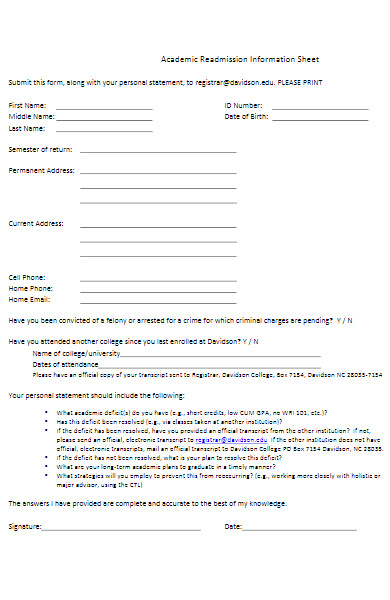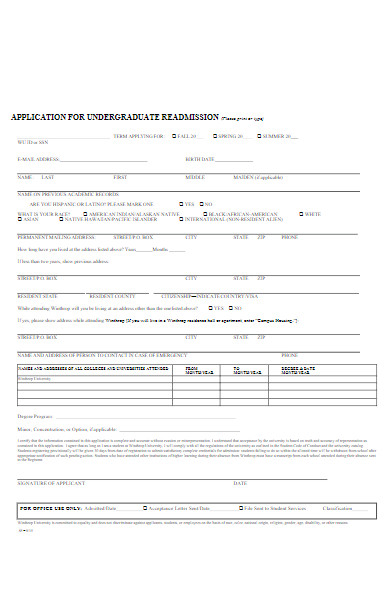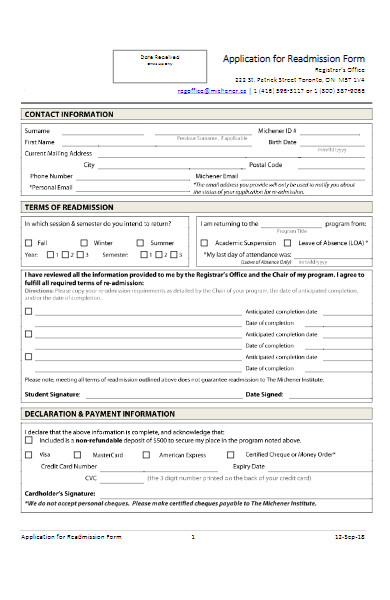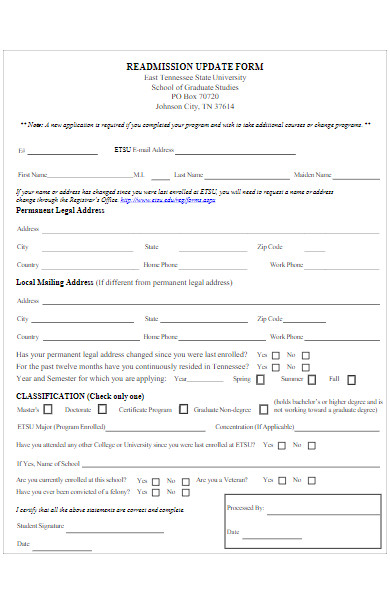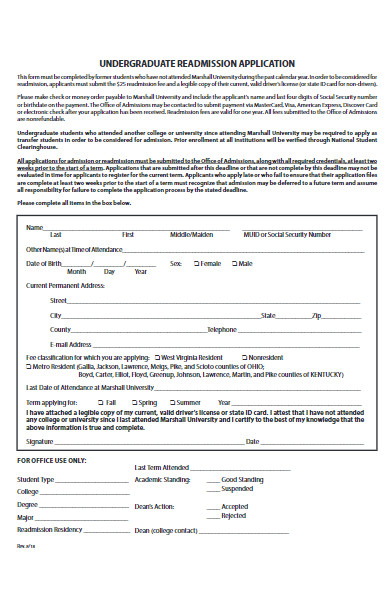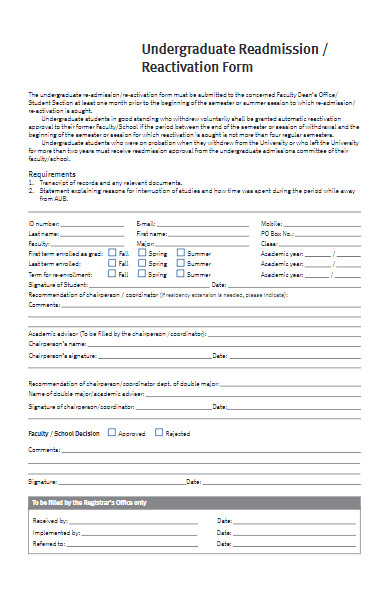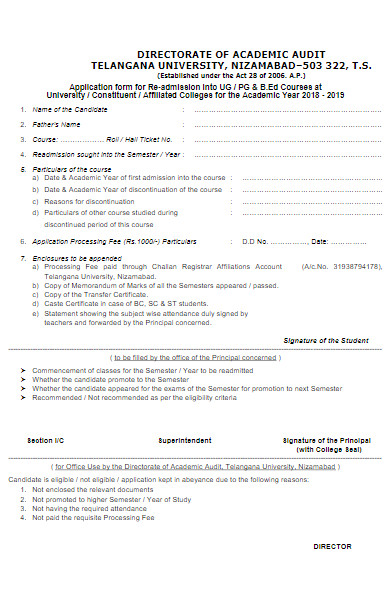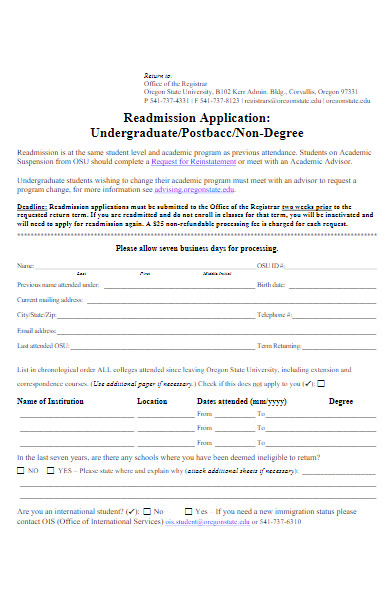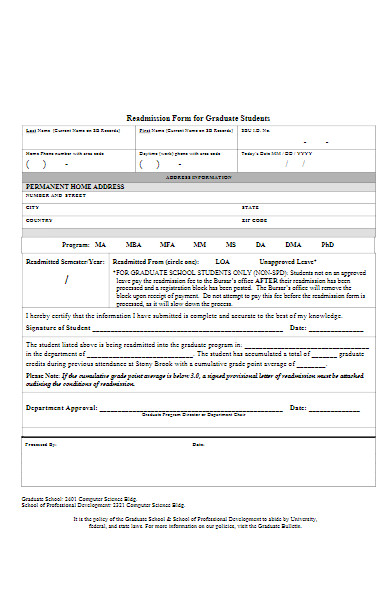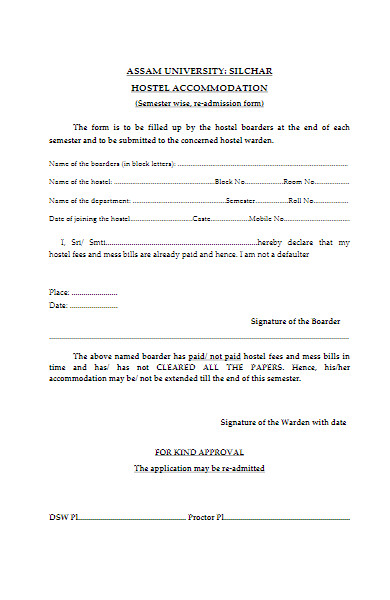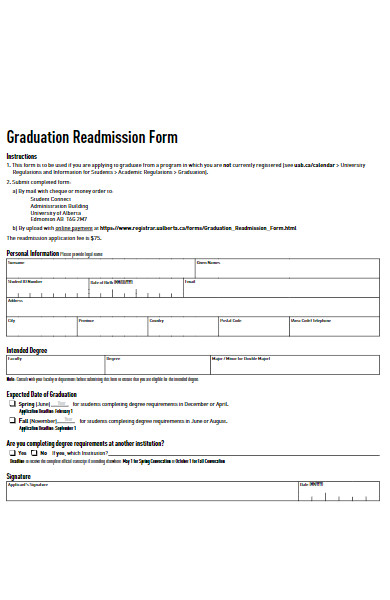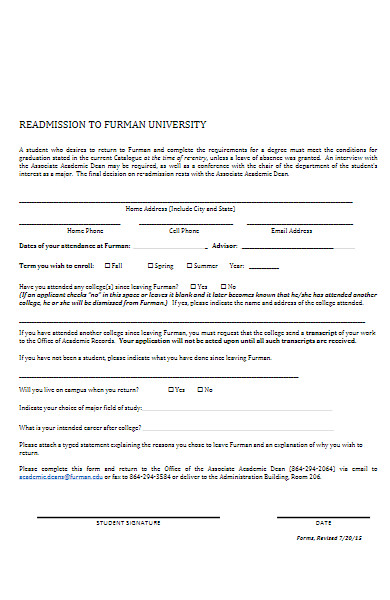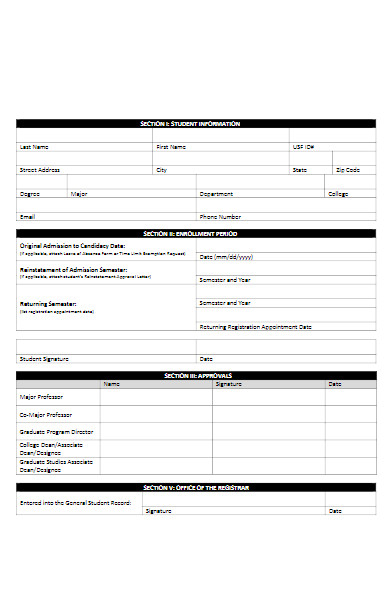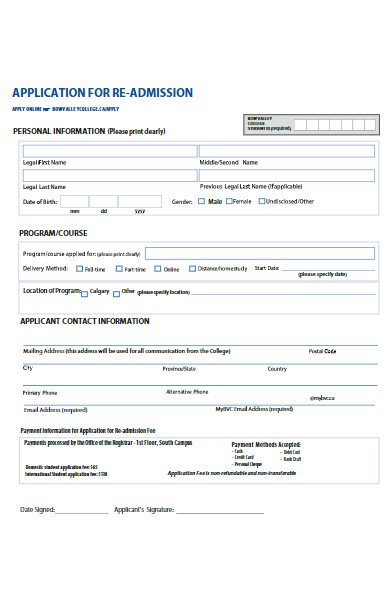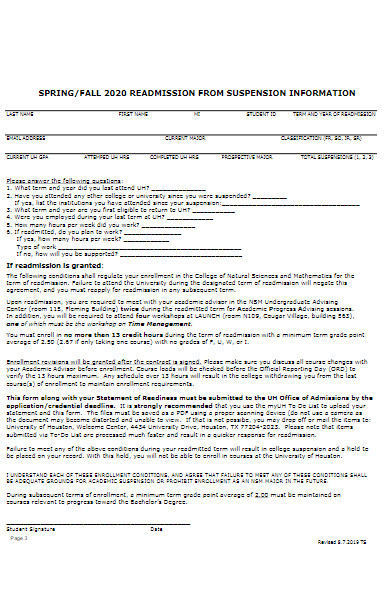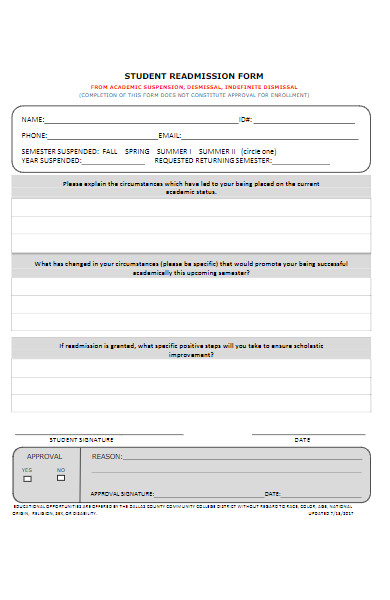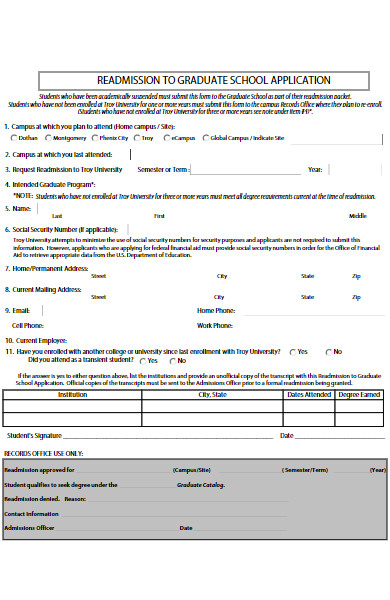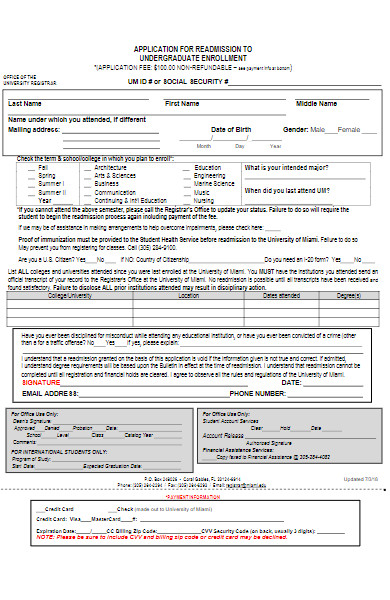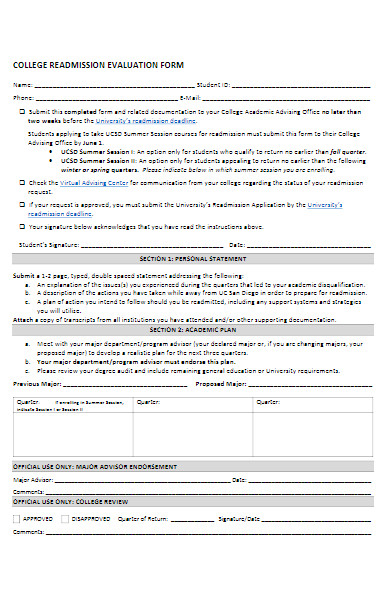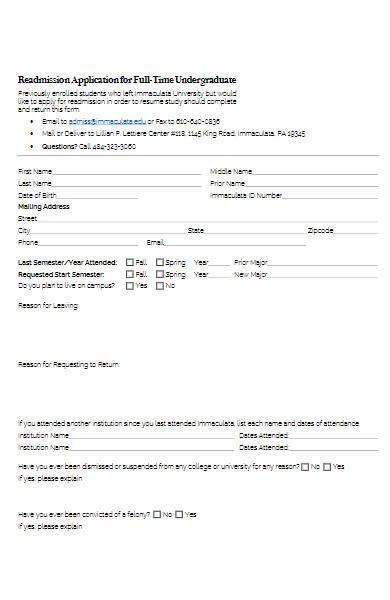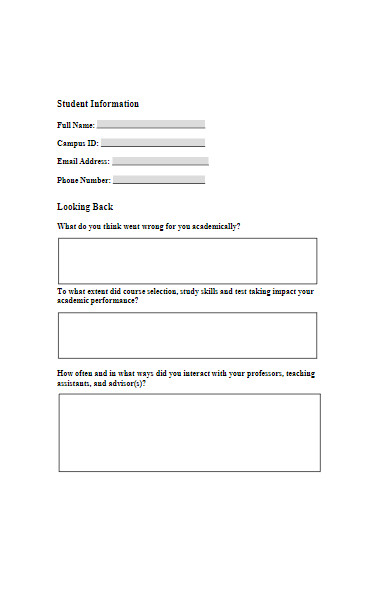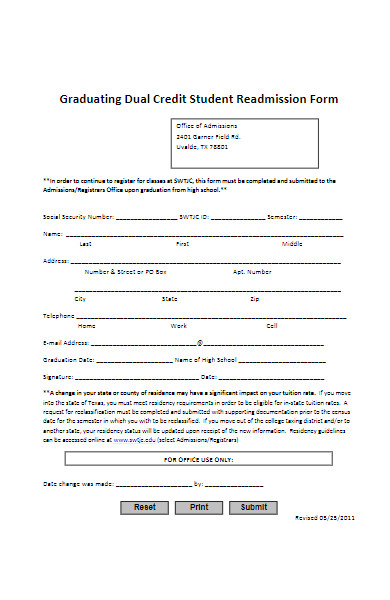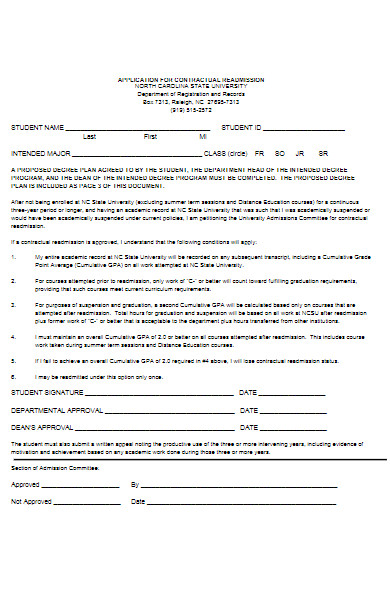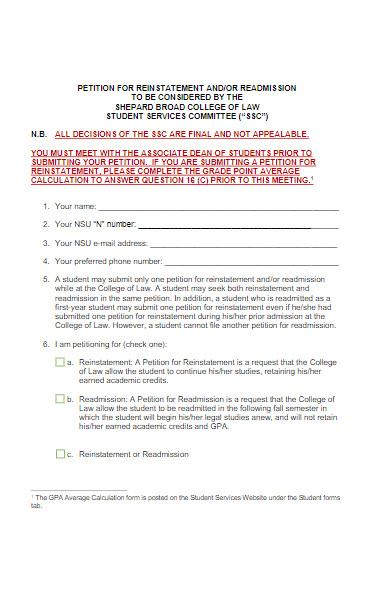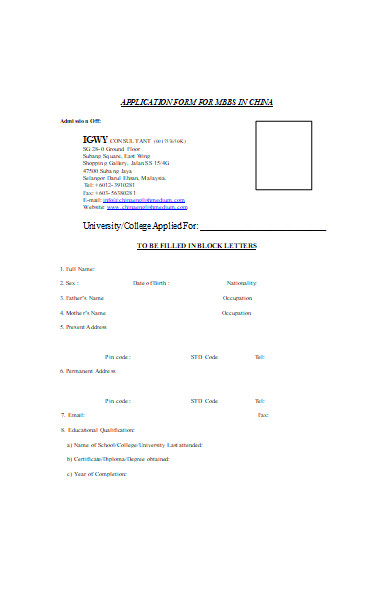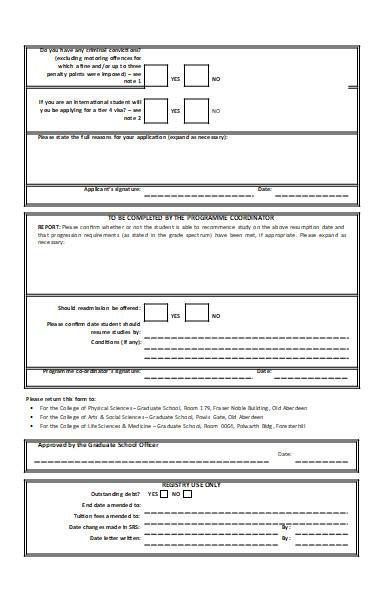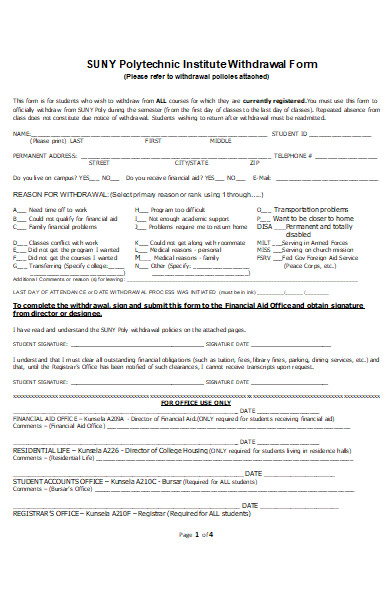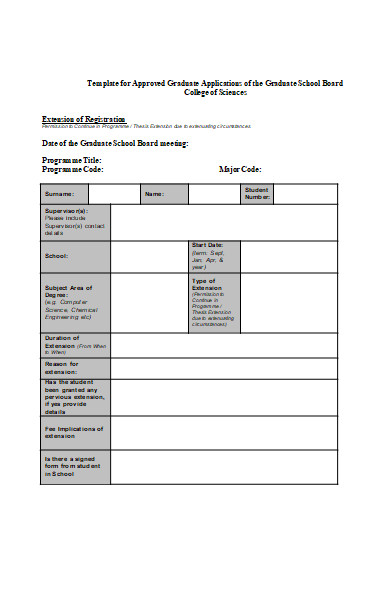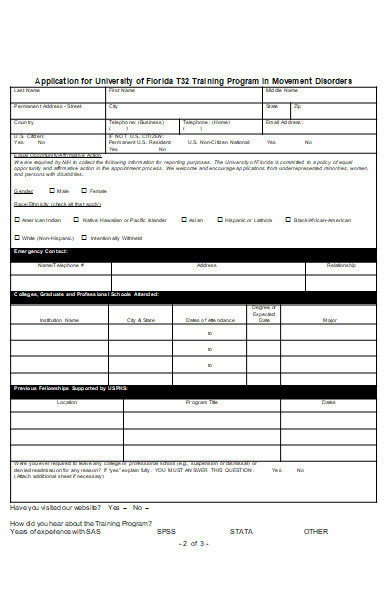A Readmission Form is an integral part of educational and healthcare institutions, serving as a bridge for those seeking re-entry after a hiatus or discontinuation. Whether a student aiming to return to an academic program or a patient revisiting a medical facility, these printable form captures the essential details and reasons for their return. Through understanding its significance, the variations it can take, its exemplary structures, creation guidelines, and best practices, one can better navigate the intricacies of readmission processes.
What is a Readmission Form ? – Definition
A Readmission Form is a formal document used by institutions, primarily educational and healthcare facilities, to facilitate the process for individuals seeking to re-enter or continue their association after a period of absence or discontinuation. In educational settings, it’s utilized by students who have previously withdrawn or been suspended and wish to return. In healthcare contexts, it’s used for patients who need to be readmitted for treatment. These fillable form captures pertinent details, reasons for the initial departure, and any conditions or prerequisites for readmission.
What is the Meaning of a Readmission Form?
The meaning of a Readmission Form revolves around its role as a gateway for re-entry into an institution. It signifies an individual’s intent to re-establish their association with an institution after a break or interruption. In an educational context, it indicates a student’s desire to resume studies after withdrawal, suspension, or an extended leave. In healthcare, it represents a patient’s need to return for continued or new treatment. Beyond mere intent, the form also gathers essential data, offering the institution insights into the reasons for the initial departure and helping determine the terms or conditions of the individual’s return.
What is the Best Sample Readmission Form?
The best sample Readmission Form will vary based on the institution’s specific requirements, be it an educational institution or a healthcare facility. However, I can provide a generic outline for a readmission form for an educational setting:
[Institution Name] – Student Readmission Form
Personal Details:
- Full Name: ________________________
- Student ID: ________________________
- Date of Birth: ________________________
- Contact Number: ________________________
- Email Address: ________________________
- Address: ________________________
Previous Enrollment Information:
- Last Semester/Year Enrolled: ___________
- Program/Major: ________________________
- Reason for Leaving/Discontinuation: ________________________
Reason for Readmission: [Provide space for a detailed answer, or use checkboxes with common reasons and an “Other” option]
Academic Performance:
- Cumulative GPA: ___________
- Any Previous Academic Probations or Suspensions: Yes/No (If yes, provide details)
Supporting Documents:
- Academic transcripts (if applicable)
- Recommendation letter(s) (if applicable)
- Medical reports (if health issues led to the departure)
- Other relevant documents: ________________________
Declaration: I, [Name], declare that the information provided above is accurate to the best of my knowledge and that I have abided by the institution’s policies during my previous enrollment.
Signature: ________________________ Date: ___________
Note: The structure and elements of the form will differ based on the institution’s needs and the specific context (e.g., undergraduate vs. graduate, medical vs. academic). It’s essential to customize the form to match the institution’s specific requirements. You should also take a look at our medical clearance form.
FREE 50+ Readmission Forms
51. Application Form for Nursing Readmission

How to fill out a college Readmission Form?
Filling out a college readmission form involves a step-by-step process, tailored to the specific requirements of each institution. However, most colleges have a relatively standardized procedure. Here’s a general guideline on how to fill out such a form:
-
Personal Details:
- Start by providing your personal information such as your full name, date of birth, and contact information (phone number, email address).
-
Student Identification:
- Provide your student ID number or any other identification number assigned to you during your previous attendance.
-
Previous Enrollment Details:
- Indicate the last semester or year you were enrolled and the reason for your absence or withdrawal.
-
Reason for Readmission:
- Some forms may require you to write a brief essay or statement explaining why you want to return and why you believe you’ll be successful upon your return.
-
Academic History:
- List any colleges or universities you attended since leaving, including dates of attendance, degrees sought or received, and academic standing.
-
Supporting Documents:
- Attach any required supporting documents. This can include transcripts from other institutions attended during your absence, letters of recommendation, medical documentation (if withdrawal was due to health reasons), or any other relevant documents.
-
Program or Major:
- Indicate the program or major you’re seeking readmission into. If you’re changing your major, specify the new program you’re interested in.
-
Additional Information:
- Some forms may have sections for additional information where you can provide details of any personal or academic achievements since your last enrollment.
-
Review & Check:
- Go through the entire form to ensure all provided information is accurate and complete. Make sure you haven’t missed any sections.
-
Signature:
- Sign and date the form. Some institutions may require this to be done in the presence of a witness or notary.
-
Submission:
- Follow the college’s instructions for submission, which might be via mail, in person, or electronically. Ensure you submit before any specified deadline.
-
Follow Up:
- After submission, it’s a good practice to follow up to ensure your application was received and to inquire about any additional steps or interviews.
Always refer to the specific guidelines provided by the college or university you’re applying to, as requirements can vary. If you’re unsure about any aspect of the form, reach out to the admissions or registrar’s office for clarity. You should also take a look at our Admission Forms.
Where can I download a university Readmission Form?
To download a university readmission form, follow these general steps:
-
Official University Website:
- Start by visiting the official website of the university you wish to be readmitted to.
- Often, the “Admissions” or “Registrar” sections will have the relevant forms. Look for subsections labeled “Readmission” or “Returning Students.”
-
Search Function:
- If you can’t find the form easily, use the search function on the university’s website. Type in “readmission form” or related keywords to narrow down the results.
-
Student Portal:
- If you were previously enrolled, you might still have access to the student portal or intranet. This can sometimes contain the forms and documents you need.
-
Contact the Admissions Office:
- If you can’t locate the form online, it might not be available for public download. In this case, reach out to the Admissions Office or the Registrar’s Office directly. They can guide you on how to obtain the form, whether by sending it to you directly or pointing you to the correct online location.
-
University Libraries or Resource Centers:
- Sometimes, university libraries or student resource centers might have physical copies of the form or know where to direct you online.
-
Third-party Websites:
- Be cautious about downloading forms from third-party websites. While some might be legitimate, there’s no guarantee that the form will be the most up-to-date version or that it hasn’t been altered.
-
Download and Save:
- Once you’ve located the form, download it to your device. Make sure to save a backup copy, especially if you’re filling it out electronically.
Remember to ensure you’re using the latest version of the readmission form. Universities might update their forms over time, and using an outdated form can delay or complicate the readmission process. When in doubt, always reach out directly to the university’s relevant department to verify the authenticity and currency of the form. You also browse our education application form.
What documents are needed with a Readmission Form?
When submitting a Readmission Form for a college or university, several supporting documents may be required to complete your application. Here’s a general list of documents that might be needed:
-
Transcripts:
- If you attended any other educational institution during your absence, you’ll need to provide official transcripts from those institutions.
- Some institutions might also require your transcripts from the time you previously attended.
-
Statement of Purpose or Personal Statement:
- This is an essay explaining why you left, what you’ve been doing during your absence, and why you wish to return. It can be crucial in helping the admissions committee understand your situation and intentions.
-
Recommendation Letters:
- These might be from professors, employers, or others who can attest to your character, accomplishments, and readiness to return to school.
-
Proof of Medical Treatment (if applicable):
- If you left due to medical reasons, some universities might require a statement from a healthcare professional indicating you are now fit to return to your studies.
-
Financial Statements:
- If you left due to financial reasons, or if there are outstanding fees, you might need to provide evidence of your current financial status or proof of payment.
-
Documentation of Activities During Absence:
- Any certificates, employment records, or other proof of what you’ve been doing while you were away from the university.
-
Readmission Fee:
- Some universities charge a fee for processing the readmission application.
-
Disciplinary Record:
- If your departure was due to disciplinary action, you might need to provide records or statements pertaining to the incident and any subsequent resolution or rehabilitation.
-
Academic Plan:
- Some universities might request an outline of your intended academic plan upon return, including which courses or majors you intend to pursue.
-
Any Specialized Forms or Documents:
- Depending on your reason for leaving and the specific policies of the institution, there might be additional forms or documents you need to provide.
Always check the specific requirements of the university or college to which you’re applying for readmission. They will provide a definitive list of documents and any other necessary requirements for your particular situation. Our University Forms is also worth a look at
How long does it take to process a Readmission Form?
The processing time for a Readmission Form can vary significantly based on several factors, including the college or university’s administrative procedures, the time of year, and the specific circumstances of the student’s request. Here’s a general overview:
- University’s Administrative Procedures: Some universities have a streamlined process, especially for students who haven’t been away for very long. Others might have a more thorough review, especially if the student left under academic or disciplinary issues.
- Time of Year: If you submit your Readmission Form close to or during peak application periods (e.g., just before a new semester starts), it might take longer due to the high volume of applications. Conversely, during off-peak times, the process might be quicker.
- Specific Circumstances: If you left the university under unique or complex circumstances, it might require more in-depth review and therefore take longer.
- Required Documentation: The processing time can be extended if there are missing documents or if further information is needed.
- Advisory or Committee Review: In some cases, the decision might need to be reviewed by an advisory board or committee, which can also extend the processing time.
- Availability of Space: If the university or specific program to which you’re seeking readmission has limited spaces available, they might need to evaluate the entire applicant pool before making a decision, which can prolong the process.
On average, for many institutions:
- Routine Cases: For straightforward cases (e.g., a student who took a gap year with no complications), it might take a few weeks to a month.
- Complex Cases: For more complicated situations (e.g., academic probation, disciplinary issues, or extended absences), it could take several weeks to a few months.
It’s essential to reach out to the specific admissions or registrar’s office of the college or university in question to get a more accurate estimate for their processing times. Also, ensure you submit your application and all required documents well in advance of any deadlines to give the institution ample time for review. you can also check student application form.
What’s the deadline for submitting a Readmission Form?
The deadline for submitting a Readmission Form varies from one educational institution to another and can also depend on the specific semester or term for which you’re seeking readmission. Here are some general guidelines:
- Fall Semester/Quarter: For institutions that operate on a traditional academic calendar with a fall start, the deadline for readmission forms for the fall term might be set in the late spring or early summer. Common deadlines could be in May, June, or July.
- Spring Semester/Quarter: For the spring term, deadlines might fall in the late fall or early winter, such as November or December.
- Summer Session: If you’re seeking readmission for a summer term, the deadline could be in the early spring, such as March or April.
- Rolling Deadlines: Some institutions might have rolling deadlines, meaning they accept readmission applications continuously and process them as they come in. However, even with rolling admissions, there may be a final cutoff after which applications won’t be considered for the upcoming term.
- Special Programs: If you’re part of a particular academic program, honors college, or other specialized areas of study, there might be separate or additional deadlines to consider.
- Extended or Unique Circumstances: If your absence from the institution was due to medical, military, or other specific reasons, there might be different deadlines or processes for your readmission.
It’s crucial to consult the college or university’s official website or contact the admissions or registrar’s office directly to determine the precise deadline for your situation. This ensures you don’t miss out and provides you with the most accurate and updated information. If you’re nearing or past a stated deadline, it’s still worth reaching out to the institution; in some cases, exceptions or extensions might be granted based on individual circumstances. In addition, you should review our College Application Forms.
Do all colleges require a Readmission Form after a break?
No, not all colleges require a Readmission Form after a break. However, the process for returning after a break in enrollment varies widely among institutions. Here’s a general overview:
- Formal Readmission Process: Many colleges and universities do have a formal readmission process in place for students who have taken a break from their studies. This could be due to academic reasons, personal issues, health concerns, or other factors. If a student is away for more than a specified duration (e.g., more than a semester or a year), they might need to fill out a Readmission Form to re-enroll.
- Automatic Re-enrollment: Some institutions may allow students to return after a short break (like a single semester) without a formal readmission process. Instead, they might only need to register for classes for the upcoming term.
- Leave of Absence: Some colleges have a “Leave of Absence” policy where students can inform the institution in advance about their intent to take a break. If the break is within the allowed duration of the leave (e.g., up to a year), returning might not require a readmission process.
- Extended Absences: If a student’s break extends beyond a certain period, the college might treat their return as a new admission. This means the student might have to reapply as if they were a new student, potentially including submitting transcripts, essays, or letters of recommendation.
- Special Programs: Students in specialized or competitive programs might have different requirements. Even a short break might necessitate a readmission process due to the structured nature of these programs.
- Community Colleges vs. Four-Year Institutions: Community colleges might have more flexible policies regarding breaks in enrollment compared to four-year institutions.
- Graduate Programs: For graduate or professional programs, the policies can be different from undergraduate programs, and often more stringent.
It’s essential for students to check with their specific institution’s policies and guidelines when considering or returning from a break. Consulting with an academic advisor or the registrar’s office can provide clarity on what steps need to be taken. You may also be interested in our Nursery Forms .
How to write a letter of explanation for a Readmission Form?
Writing a letter of explanation for a Readmission Form is a chance to clarify the reasons for your absence and to demonstrate your commitment and preparedness to return to your studies. Here’s a step-by-step guide to help you craft an effective letter:
1. Header and Salutation:
- Start with your name, address, and the date at the top left corner.
- Address the letter to the appropriate recipient, e.g., “Dear Admissions Committee” or “Dear [Name of the Head of Admissions/Department Head],” if known.
2. Introduction:
- Begin by stating your intent: “I am writing to provide a detailed explanation regarding my absence from [College/University Name]…”
- Mention your previous enrollment details like your student ID, major, and the last semester/year you attended.
3. Clearly State the Reason for Your Absence:
- This section is crucial. Be concise and honest about why you had to leave or take a break. Whether it was due to medical, personal, financial reasons, or other challenges, clearly articulate the circumstances.
4. Provide Evidence (If Applicable):
- If your absence was due to medical reasons, you might consider attaching a doctor’s note as evidence.
- If it was due to financial challenges, briefly describe the situation and, if possible, provide documentation or evidence of resolved issues.
5. Highlight Positive Developments:
- Discuss any steps you’ve taken during your absence to prepare for your return. This could include relevant work experience, courses taken, skills acquired, or personal growth.
- If you’ve addressed and resolved the issue(s) that led to your break, mention that too.
6. Reiterate Your Commitment:
- Express your eagerness to return to your studies and contribute positively to the university community.
- If you’ve consulted with an academic advisor or department head during your time away, mention this to show your proactive approach.
7. Keep It Professional:
- While it’s okay to express emotions, remember to keep the tone of your letter professional. Avoid using overly informal language.
8. Conclusion:
- Summarize your main points.
- Express gratitude for their consideration: “Thank you for taking the time to consider my application for readmission.”
9. Signature:
- Close the letter with “Sincerely” or “Kind Regards,” followed by your signature (if sending a hard copy) and your typed name.
10. Proofread and Review:
- Before submitting, make sure to proofread your letter for grammar, punctuation, and clarity. If possible, ask someone else to review it as well.
Remember, your goal is to help the admissions committee understand the circumstances that led to your absence and to show that you’re ready and committed to resume your studies successfully. You may also be interested to browse through our other primary school admission form.
How to Create a Readmission Form?
How to Create a Readmission Form: A Step-by-Step Guide
Creating a readmission form is essential for educational institutions to streamline the process for students seeking to return after a prolonged absence. Here’s a comprehensive guide on how to design one:
1. Start with Basic Information:
- Title: Clearly label the document as “Readmission Form” at the top.
- Date: Include a space for the student to input the date of form submission.
- Institution’s Name and Logo: Incorporate your institution’s branding.
2. Student’s Personal Details:
- Full Name
- Student ID Number (if previously assigned)
- Date of Birth
- Contact Information: Including address, phone number, and email.
3. Previous Enrollment Details:
- Last Semester/Year Attended: This helps identify when the student was last active.
- Program/Major: To determine which department should process the readmission.
- Reason for Leaving: Space for a brief explanation about the initial departure.
4. Duration of Absence:
- Start Date of the break.
- Expected Return Date: Helps in academic planning.
5. Reason for Readmission: Provide multiple choices with checkboxes for common reasons, such as:
- Medical issues
- Financial challenges
- Personal/family matters
- Others (with a space for detailed explanation)
6. Attachments Section:
- Specify what documents, if any, need to accompany the form. This might include medical records, letters of explanation, or other relevant paperwork.
7. Academic Plan:
- Courses Intended to Take: This helps in understanding the student’s academic intentions upon return.
- Study Plan: A brief description of how they plan to achieve their academic goals.
8. Declaration and Signature:
- Include a statement that all information provided is accurate to the best of the student’s knowledge.
- Space for the student’s signature and date.
9. Instructions and Guidelines:
- Clearly mention the submission deadline, if any.
- Specify where and how to submit the form (e.g., to the admissions office, via email).
- List out any processing fees or other requirements.
10. For Office Use Only Section:
- Received Date: When the form was received by the institution.
- Processed By: Name/signature of the official who processed the form.
- Decision: Options such as “Approved”, “Denied”, or “Pending Further Review”.
- Comments/Notes: Space for any notes by the administrative staff.
11. Design and Format:
- Use clear headings and subheadings.
- Ensure adequate spacing for easy readability.
- Use a consistent font and font size throughout.
12. Proofread and Review:
- Double-check the form for any grammatical or typographical errors.
- Ensure that all necessary sections are included and that instructions are clear.
13. Get Feedback: Before finalizing, it might be beneficial to get feedback from both administrative staff and a few students to ensure the form is comprehensive and user-friendly.
14. Distribute and Implement: Once finalized, make the form accessible. This might include posting it on the institution’s website, having copies available at the admissions or registrar’s office, and informing advisors or counselors about its availability.
By following these steps, you can design a comprehensive readmission form that simplifies the process for returning students and ensures the institution has all the information needed for a smooth transition. You should also take a look at our Hospital Forms.
Tips for creating an Effective Readmission Form
Tips for Creating an Effective Readmission Form
- Simplicity is Key: Aim for clarity and conciseness. Ensure the form is easy to understand and fill out, avoiding unnecessary jargon or complicated instructions.
- Logical Flow: Organize the form in a logical sequence. Begin with personal details, move on to academic history, and conclude with the reason for readmission and any additional requirements.
- Clear Headings: Use bold and clear headings for different sections to make the form easy to navigate.
- Provide Clear Instructions: Right at the beginning, offer clear and concise instructions about how to fill out the form, any required attachments, and the submission process.
- Use Multiple-Choice Questions: Wherever possible, use checkboxes or radio buttons for standard answers, which makes it easier for students and quicker for administrative processing.
- Keep it Digital-Friendly: In today’s age, it’s helpful to have forms that can be filled out digitally. Ensure your form is available in a format that’s easy to fill out and submit online.
- Include an Attachments Section: Clearly indicate which supporting documents need to accompany the form. This can prevent delays and back-and-forths due to missing paperwork.
- Feedback Mechanism: Provide space for comments or feedback. This can offer insights into the student’s unique situation and reasons for readmission.
- Privacy Statement: Include a privacy statement assuring students that their data will be kept confidential and detailing how it will be used.
- Consistency in Design: Use a consistent font, style, and color scheme that aligns with the institution’s branding.
- Validation Fields: If the form is digital, use validation for fields like email addresses and phone numbers to ensure correct data input.
- Space for Official Use: Keep a designated area for administrative notes, approval/rejection stamps, and any other internal processing remarks.
- Proofread: Always double-check for typos, grammatical errors, and clarity. Have multiple people review the form to ensure it’s comprehensive.
- Regular Updates: Update the form regularly to accommodate changes in institutional policies, regulations, or based on feedback received.
- Accessibility: Ensure that the form is accessible to everyone, including students with disabilities. This might involve creating a version compatible with screen readers or offering alternative formats upon request.
- Provide Contact Details: Include a section with contact details (phone number, email) where students can reach out with questions or for clarification.
- Feedback Loop: After implementing the form, periodically gather feedback from both students and administrative staff to continuously improve the form’s effectiveness.
An effectively designed readmission form not only makes the process smoother for returning students but also ensures that the institution gathers all the necessary information in a structured and efficient manner.
A readmission form is a crucial document for students seeking re-entry into an educational institution after a hiatus. It defines their intent, reasons, and academic history. With various types tailored to different situations, creating one demands clarity and structure. By understanding its meaning, examining examples, and following creation guides, institutions can streamline the re-entry process for returning students. In addition, you should review our Enquiry Form.
Related Posts
FREE 9+ Student Affidavit Forms in PDF MS Word
FREE 9+ Sample Patient Assessment Forms in PDF MS Word | Excel
FREE 51+ Education Forms in PDF MS Word | Excel
FREE 7+ Accounting Application Forms in PDF Ms Word
FREE 11+ Training Application Forms in PDF MS Word
FREE 7+ Professional Letter of Recommendation Forms in PDF
FREE 53+ Printable Forms in PDF MS Word | Excel
FREE 12+ Education Forms for Students, Teachers, and Schools in ...
FREE 21+ Sample Printable Application Forms in PDF MS Word ...
FREE 13+ Sample Partnership Application Forms in PDF MS Word
FREE 51+ Cancellation Forms in PDF MS Word
FREE 15+ Referee Report Forms in PDF MS Word | Excel
FREE 10+ Undergraduate Application Forms in PDF MS Word
FREE 5+ College Letter of Recommendation in PDF MS Word
FREE 3+ Primary School Admission Forms in PDF
